An Environmental Critique: Impact of Socialist Ideology on the Ecological and Cultural Sensitivity of Belgrade’s Large-Scale Residential Settlements
Abstract
:1. Introduction
2. Methodological Approach
3. Background: The Importance of Sustainability Issues under the Influence of Socialist Ideology
3.1. Social and Cultural Contexts
3.2. Socialist Ideology and the Concept of Sustainability
If efforts are concentrated on creating such an environment that would be a decent place for a man to live and work, that would fully display the desires, potentials and knowledge of man, socialism may find the strength to overcome these problems. This understandably implies that the creation of a new system of socialist cultural and ethical values should also incorporate new attitudes towards our surroundings.[29]
3.3. Architectural Positions—Influences and Principles of Dominant Architectural Styles in Socialism
4. Ecological and Cultural Sensitivity
4.1. Abandonment of Traditional Values
4.2. Loss of Ambience Values
The origins of creative spatial work are related to natural conditions. Architecture and urban planning were originally an affirmation of the existence of a specific geographical place, which is structured into a geographical ambience by the reciprocity of the subject’s presence. The inseparable nature of geographical and social ambience (the so-called natural and artificial environments) in their significance for man implies the specialty and uniqueness of each individual spatial situation.[56]
5. Discussion
Acknowledgments
Author Contributions
Conflicts of Interest
References
- Blagojević, L. Strategije Modernizma u Planiranju i Projektovanju Urbane Strukture i Arhitekrure Novog Beograda: Period Konceptualne Faze od 1922. do 1962. Godine. Ph.D. Thesis, University of Belgrade, Belgrade, Serbia, 2004. [Google Scholar]
- Blagojević, L.; Ćorović, D. Klimatske promene i estetika savremene arhitekture. In Uticaj Klimatskih Promena na Planiranje i Projektovanje; Djokić, V., Lazović, Z., Eds.; Arhitektonski Fakultet: Belgrade, Serbia, 2011; pp. 19–33. [Google Scholar]
- Anker, P. From Bauhaus to Ecohouse: A History of Ecological Design; Louisiana State University Press: Baton Rouge, LA, USA, 2010. [Google Scholar]
- Corbusier, L. Atinska Povelja; Klub Mladih Arhitekata: Belgrade, Serbia, 1972. [Google Scholar]
- Ristić Trajković, J.; Stojiljković, D.; Ćirić, D. Transformation of modern urban space of New Belgrade in the conditions of the post-socialist transition and sustainable development. In Procedings of the 12th International Docomomo Conference, Espoo, Finland, 7–10 August 2012; pp. 381–388.
- Van der Ryn, S.; Cowan, S. Ecological Design; Island Press: Washington, DC, USA, 2007. [Google Scholar]
- Farmer, J. Green Shift: Towards a Green Sensibility in Architecture; Butterworth Architecture: Oxford, UK, 1996. [Google Scholar]
- Hagan, S. Taking Shape. A New Contract between Architecture and Nature; Architectural Press: Oxford, UK, 2001. [Google Scholar]
- Spiegl, A. A Panorama of the Artifactual. In Your Black Horizon Art Pavilion. Olafur Eliasson and David Adjaye; Ebersberger, E., Zyman, D., Eds.; D.A.P.: Köln, Germany; New York, NY, USA, 2007; pp. 85–141. [Google Scholar]
- Guy, S.; Farmer, G. Reinterpreting Sustainable Architecture: The Place of Technology. J. Archit. Educ. 2001, 54, 140–148. [Google Scholar] [CrossRef]
- Lefebvre, H. The Production of Space; Blackwell: Oxford, UK; Cambridge, MA, USA, 1991. [Google Scholar]
- Nikezić, A.; Marković, D. Place-Based Education in the Architectural Design Studio: Agrarian Landscape as a Resource for Sustainable Urban Lifestyle. Sustainability 2015, 7, 9711–9733. [Google Scholar] [CrossRef]
- Hawkes, D. The Environmental Imagination: Technics and Poetics of the Architectural Environment; Routledge: London, UK; New York, NY, USA, 2008. [Google Scholar]
- Soini, K.; Dessein, J. Culture-Sustainability Relation: Towards a Conceptual Framework. Sustainability 2016, 8, 167. [Google Scholar] [CrossRef] [Green Version]
- Borch, C. Architectural Atmospheres: On the Experience and Politics of Architecture; Birkhäuser: Basel, Switzerland, 2014. [Google Scholar]
- Moravánszky, A. My Blue Heaven: The Architecture of Atmospheres. AA Files 2010, 61, 18–22. [Google Scholar]
- Pallasmaa, J.; Holl, S.; Pérez Gómez, A. Questions of Perception: Phenomenology of Architecture; William Stout Publishers: San Francisco, CA, USA, 2006. [Google Scholar]
- Pallasmaa, J. Space, Place, and Atmosphere: Peripheral Perception in Existential Experience. In Architectural Atmospheres, On the Experience and Politics of Architecture; Borch, C., Ed.; Birkhäuser: Basel, Switzerland, 2014; pp. 18–41. [Google Scholar]
- Groat, L.N.; Wang, D. Architectural Research Methods; J. Wiley: New York, NY, USA, 2002. [Google Scholar]
- Ristić Trajković, J.; Stojiljković, D.; Međo, V. Influence of the Socialist Ideology on the Conception of Multi-Family Housing: New Urban Landscape and the Typological Models of Housing Units. Facta Univ. Ser. Archit. Civil Eng. 2015, 13, 167–179. [Google Scholar] [CrossRef]
- Jovanović-Nenadović, L. Koncepcija Projektovanja Stambenih Jedinica u Novom Beogradu—Analiza Konkursnih Rešenja u Periodu 1966–1975. Godine. Master’s Thesis, University of Belgrade, Belgrade, Serbia, 2011. [Google Scholar]
- Ristić Trajković, J. Architecture and Nature: The Application of Environment-Behavior Theories in Architectural Design. Ph.D. Thesis, University of Belgrade, Belgrade, Serbia, 2015. [Google Scholar]
- Marković, D.Ž. Socijalna Ekologija; Zavod za Udžbenike i Nastavna Sredstva: Belgrade, Serbia, 1986. [Google Scholar]
- United Nations. Report of the World Commission on Environment and Development. In General Assembly Resolution 42/187; United Nations: New York, NY, USA, 1987. [Google Scholar]
- Čiček, J. Samoupravne intresne zajednice za zaštitu čovjekove okoline. Čovjek i Prostor 1975, 269, 21–23. [Google Scholar]
- Keller, G. Budućnost kakvu zavređujemo. Čovjek i Prostor 1973, 241, 19–22. [Google Scholar]
- Kiš, D. Ekologija i prostorno planiranje. Čovjek i Prostor 1973, 238, 16–18. [Google Scholar]
- Kiš, D. Čovjekova sredina u vrijeme brze urbanizacije u Jugoslaviji. Čovjek i Prostor 1971, 225, 32. [Google Scholar]
- Keller, G. Socijalizam i ekologija. Čovjek i Prostor 1973, 243, 24. [Google Scholar]
- M., F. Marksistički pristup ekologiji. Čovjek i Prostor 1978, 309, 4. [Google Scholar]
- Meštrović, M. Uporaba okoline. Čovjek i Prostor 1979, 313, 19. [Google Scholar]
- Petrinović, Z. Svjetski dan urbanizma i čovjekove sredine. Čovjek i Prostor 1973, 242, 27. [Google Scholar]
- Stojanović, B. Odnos prema prirodi. In 40 Godina Građevinarstva Socijalističke Republike Srbije; Jarić, M., Ed.; Izgradnja: Belgrade, Serbia, 1987; pp. 73–74. [Google Scholar]
- Karnovšek Ljuckanov, N. U susret sunčanoj energiji. Čovjek i Prostor 1978, 300, 13. [Google Scholar]
- Venturini, D. Komercijalna upotreba sunčane energije. Čovjek i Prostor 1978, 300, 13. [Google Scholar]
- Ragon, M. Urbanizam i sunčana energija. Čovjek i Prostor 1974, 258, 20–21. [Google Scholar]
- Lukić, M. Emocionalni i psihološki aspekti stanovanja u novim naseljima. Urban. Beogr. 1979, 53–54, 33–36. [Google Scholar]
- Groat, L.N.; Despres, C. The Significance of Architectural Theory for Environmental Design Research. In Advances in Environment, Behavior, and Design; Zube, E.H., Moore, G.T., Eds.; Plenum Press: New York, NY, USA; London, UK, 1991; Volume 3. [Google Scholar]
- Banham, R. The Architecture of the Well-tempered Environment; Architectural Press: London, UK, 1984. [Google Scholar]
- Corbusier, L. The City of Tomorrow; Architectural Press: London, UK, 1987. [Google Scholar]
- Ribnikar, V. Problem stanbenih zgrada. Arhitektura 1950, 11–12, 16–19. [Google Scholar]
- Jencks, C. The Language of Post-Modern Architecture, 6th ed.; Rizzoli: New York, NY, USA, 1991. [Google Scholar]
- Appleyard, D. The Environment as a Social Symbol: Within a Theory of Environmental Action and Perception. J. Am. Plan. Assoc. 1979, 45, 143–153. [Google Scholar] [CrossRef]
- Harvey, D. The Condition of Postmodernity; Blackwell Publishing: Oxford, UK, 1990. [Google Scholar]
- Savetovanje, B. Budućnost stambenih naselja. Beograd 26. 27. i 28. maj 1977. Stenografske beleške sa plenarne sednice 28. maj 1977. godine. In Komunikacije ’77; Centar za Planiranje Urbanog Razvoja: Belgrade, Serbia, 1977. [Google Scholar]
- Radna Grupa, D. Kako početi život u novom naselju—Problemi identifikacije i socijalne integracije. In Budućnost Stambenih Naselja. Planiranje, Programiranje, Urbanističko Projektovanje, Realizacija, Korišćenje. Komunikacije ’77; Centar za Planiranje Urbanog Razvoja: Belgrade, Serbia, 1977. [Google Scholar]
- Perović, M. Iskustva Prošlosti; Plato: Belgrade, Serbia, 2000. [Google Scholar]
- Google Maps. Available online: https://www.google.rs/maps/search/%D0%91%D0%BB%D0%BE%D0%BA+1+2,+%D0%91%D0%B5%D0%BE%D0%B3%D1%80%D0%B0%D0%B4/@44.8255724,20.4049091,1313m/data=!3m1!1e3?hl=sr (accessed on 10 July 2016).
- Google Maps. Available online: https://www.google.rs/maps/place/%D0%91%D0%BB%D0%BE%D0%BA+1,+%D0%91%D0%B5%D0%BE%D0%B3%D1%80%D0%B0%D0%B4/@44.7814675,20.3848966,16234m/data=!3m1!1e3!4m5!3m4!1s0x475a6579ddf0dedd:0xebad449c9fc960e8!8m2!3d44.8230969!4d20.4102172?hl=sr (accessed on 10 July 2016).
- Ignjatović, A. Poricanje i obnova: Arhitektura postmodernizma 1980–1991. In Istorija Umetnosti u Srbiji XX vek; Šuvaković, M., Ed.; Orion Art: Belgrade, Serbia, 2010; pp. 663–670. [Google Scholar]
- Böhme, G. Urban Atmospheres: Charting New Directions for Architecture and Urban Planning. In Architectural Atmospheres: On the Experience and Politics of Architecture; Borch, C., Ed.; Birkhäuser: Basel, Switzerland, 2014; pp. 42–59. [Google Scholar]
- Dakić, S.; Kritovac, F. Okolina Je Proces. Teoretske Mogućnosti Jedne Nove Prakse. Arhitektura 1973, 146–147. Available online: http://www.uha.hr/hr/publikacije/casopisi/arhitektura/ARHITEKTURA-146-147~no16131/Okolina-je-proces-teoretske-mogucnosti-jedne-nove-prakse~no16140/ (accessed on 8 September 2016). [Google Scholar]
- Pasinović, A. Integritet prostornog jedinstva. Arhitektura 1969, 104, 5–7. [Google Scholar]
- Dobrović, N. Osvrt na temu ambijent. Arhitektura 1965, 90, 7. [Google Scholar]
- Google Maps. Available online: https://www.google.rs/maps/place/%D0%91%D0%BB%D0%BE%D0%BA+21,+%D0%91%D0%B5%D0%BE%D0%B3%D1%80%D0%B0%D0%B4/@44.8153885,20.4266243,1261m/data=!3m1!1e3!4m5!3m4!1s0x475a655e88abab17:0xf9dfbd3e64bd807e!8m2!3d44.8145051!4d20.4303868?hl=sr (accessed on 10 July 2016).
- Marušić, M.; Marušić, D. Cerak 1 i Cerak 2. Cerak u 20 slika. In 40 Godina Građevinarstva Socijalističke Republike Srbije; Jarić, M., Ed.; Izgradnja: Belgrade, Serbia, 1987; pp. 127–136. [Google Scholar]
- Manević, Z. Lojanica, Jovanović, Cagić: Julino brdo u Beogradu. Čovjek i Prostor 1971, 217, 10–12. [Google Scholar]
- Wikipedia. Julino Brdo. Available online: https://sr.wikipedia.org/wiki/%D0%88%D1%83%D0%BB%D0%B8%D0%BD%D0%BE_%D0%B1%D1%80%D0%B4%D0%BE#/media/File:Julino_brdo_from_airplane.jpg (accessed on 10 July 2016).
- Mišić, R. Novi Beograd sa gledišta urbane higijene. Novi Beograd—Novi grad u Gradu. Urban. Beogr. 1973, 25, 4–7. [Google Scholar]
- Lukić, M. Zelenilo kao urbanistička komponenta. Čovjek i Prostor 1965, 149–150, 5. [Google Scholar]
- Lazić, S. Kako stanovnici doživljavaju otvorene prostore stambenih naselja. Arhit. Urban. 1976, 74–77, 94–97. [Google Scholar]
- Lojanica, M. Blok 19a u Novom Beogradu. In 40 Godina Građevinarstva Socijalističke Republike Srbije; Jarić, M., Ed.; Časopis Izgradnja: Beograd, Serbia, 1987; pp. 123–126. [Google Scholar]
- Mutnjaković, A. Grad našeg radosnog sutra. Arhit. Urban. 1964, 25, 22–23. [Google Scholar]
- Meštrović, M. U procijepu između umjetnosti i nauke. Arhit. Urban. 1964, 25, 19–20. [Google Scholar]
- Dayaratne, R. Environment-Behavior Research and the Practice of Architecture: Paradigms and Paradoxes. BuiIt Environ. Sri Lanka 2002, 3, 38–45. [Google Scholar] [CrossRef]
- Lang, J. Design Theory from an Environment and Behavior Perspective. In Advances in Environment, Behavior, and Design; Zube, E.H., Moore, G.T., Eds.; Plenum Press: New York, NY, USA; London, UK, 1991; Volume 3, pp. 53–102. [Google Scholar]
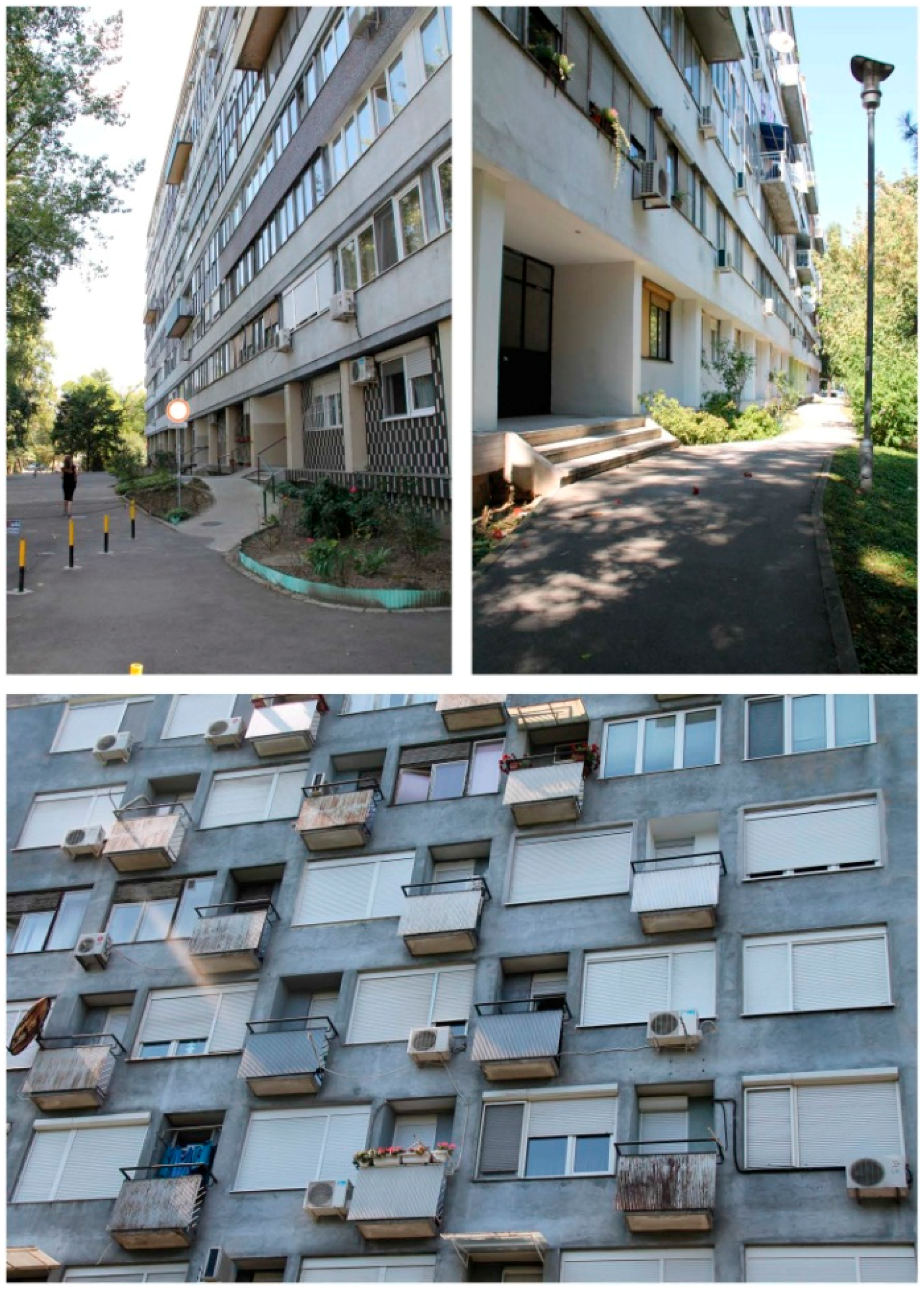

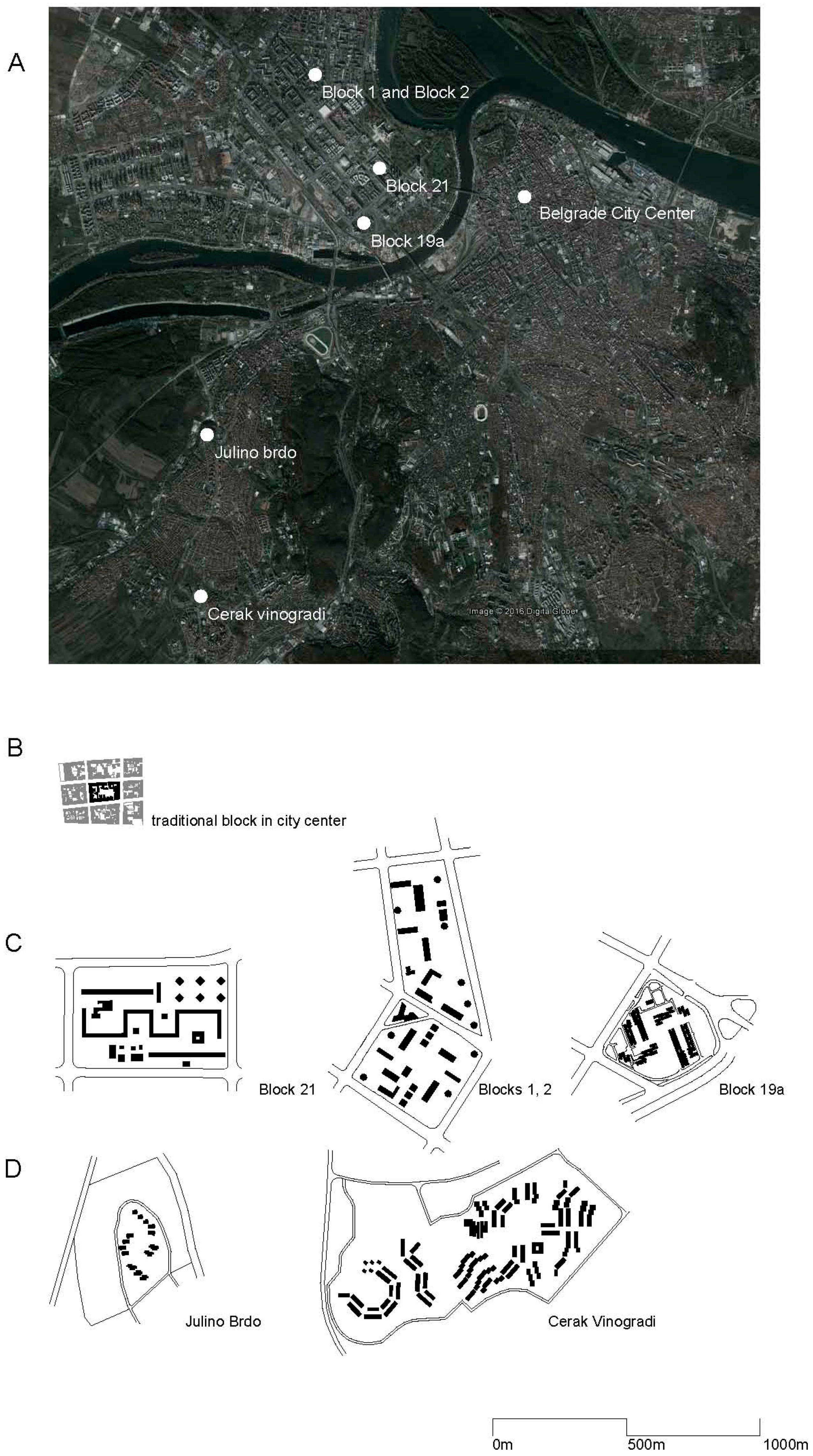
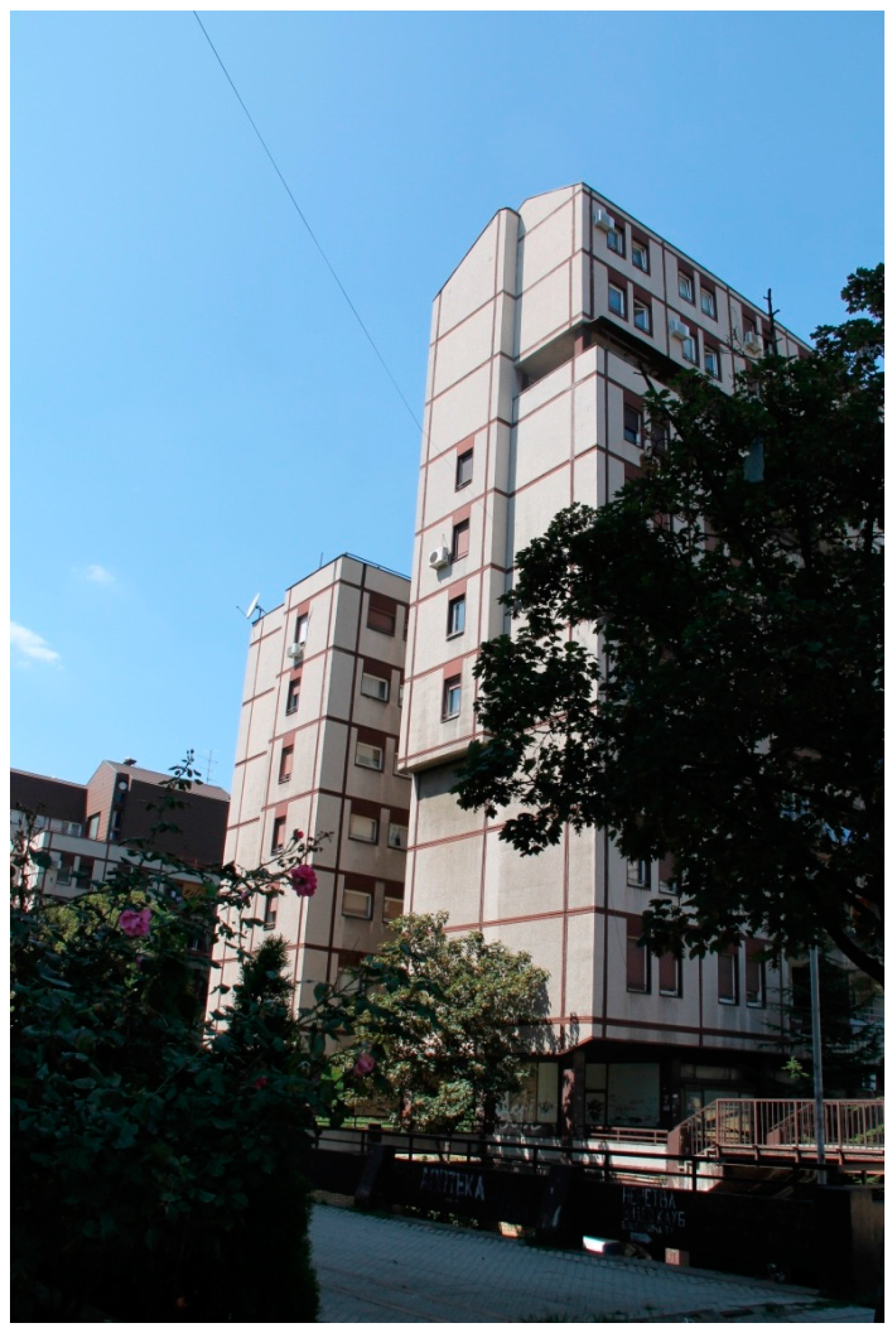
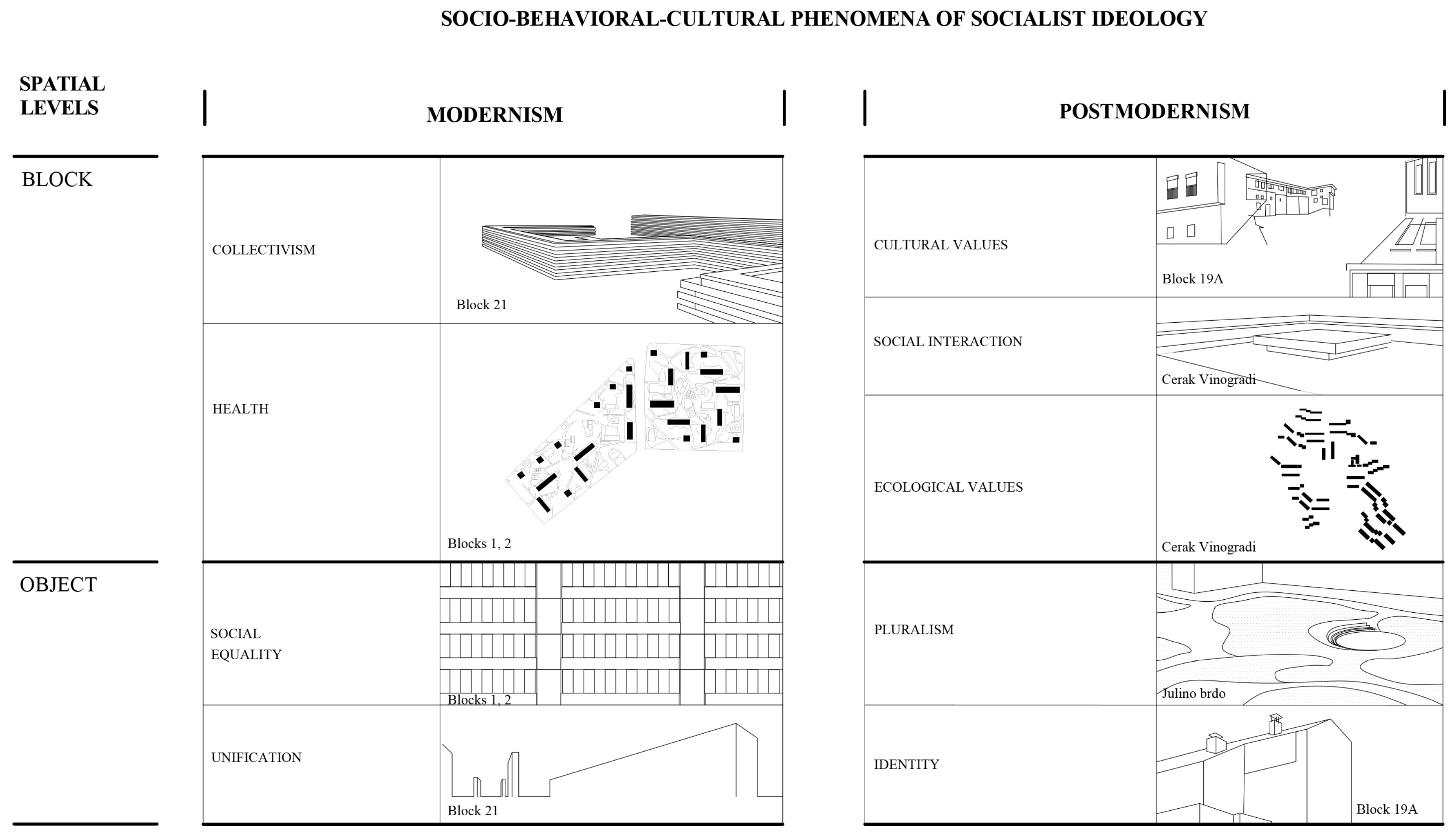
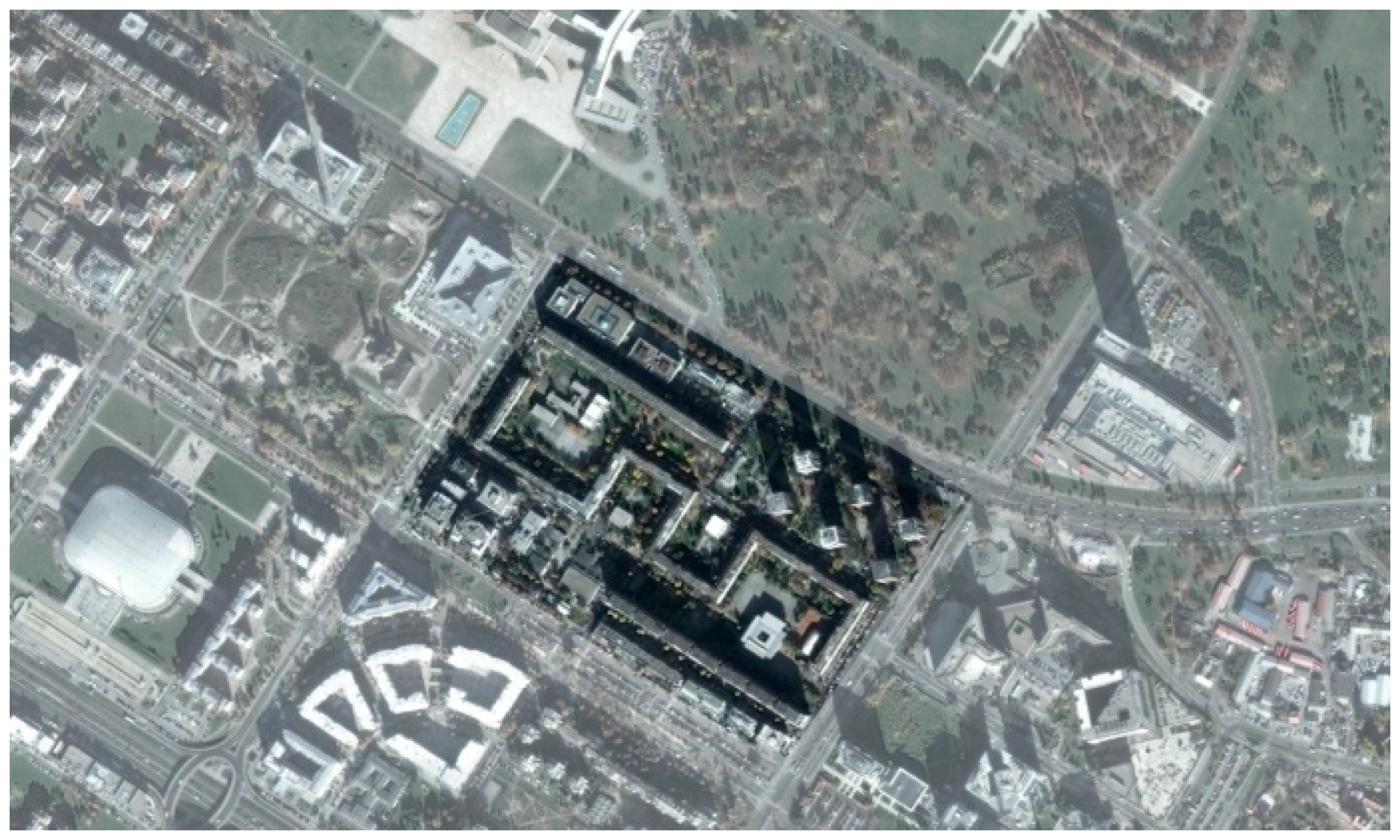
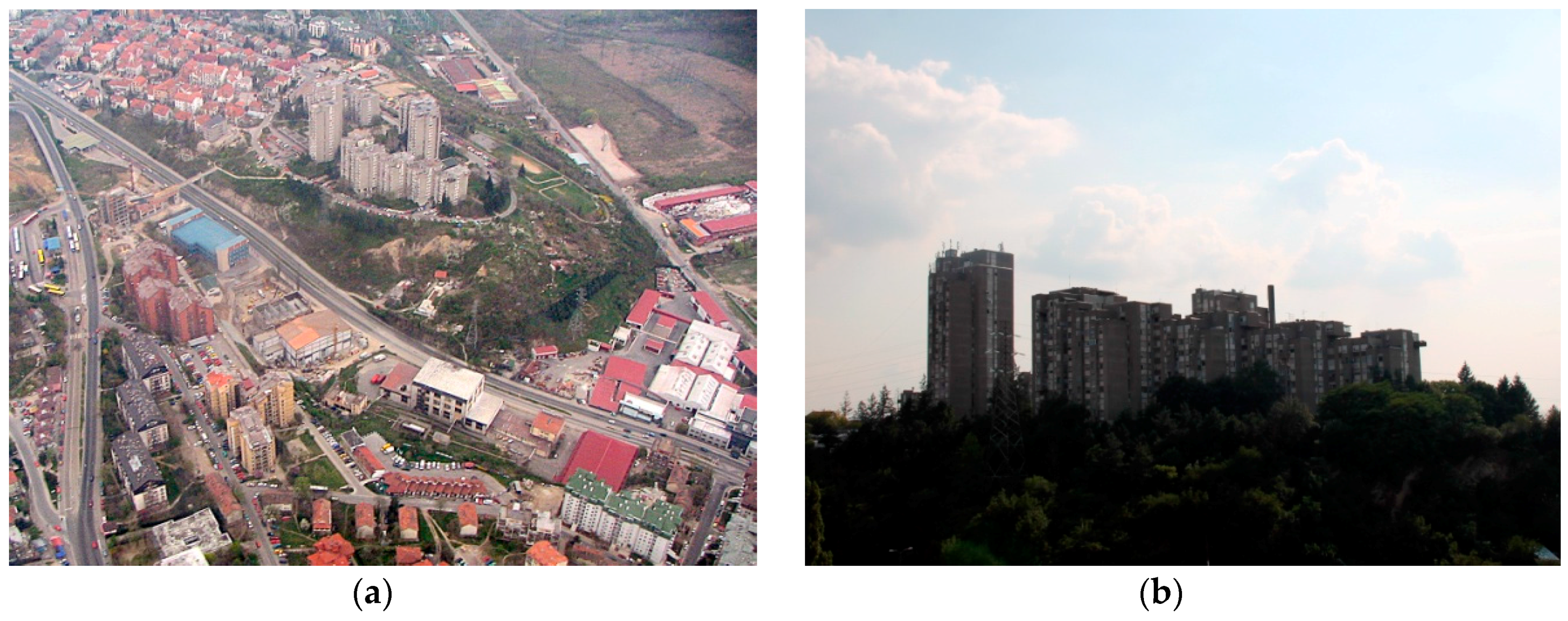
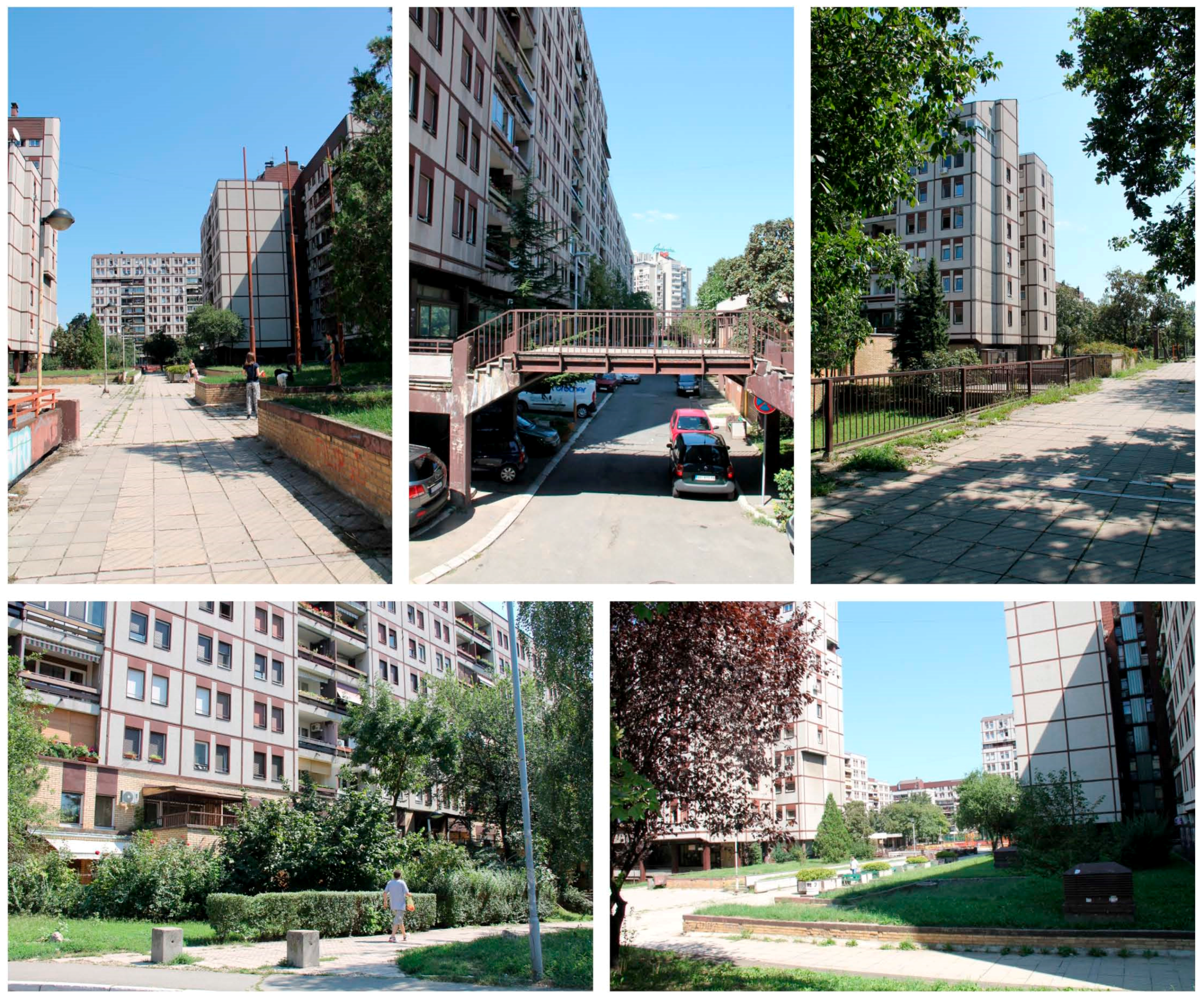
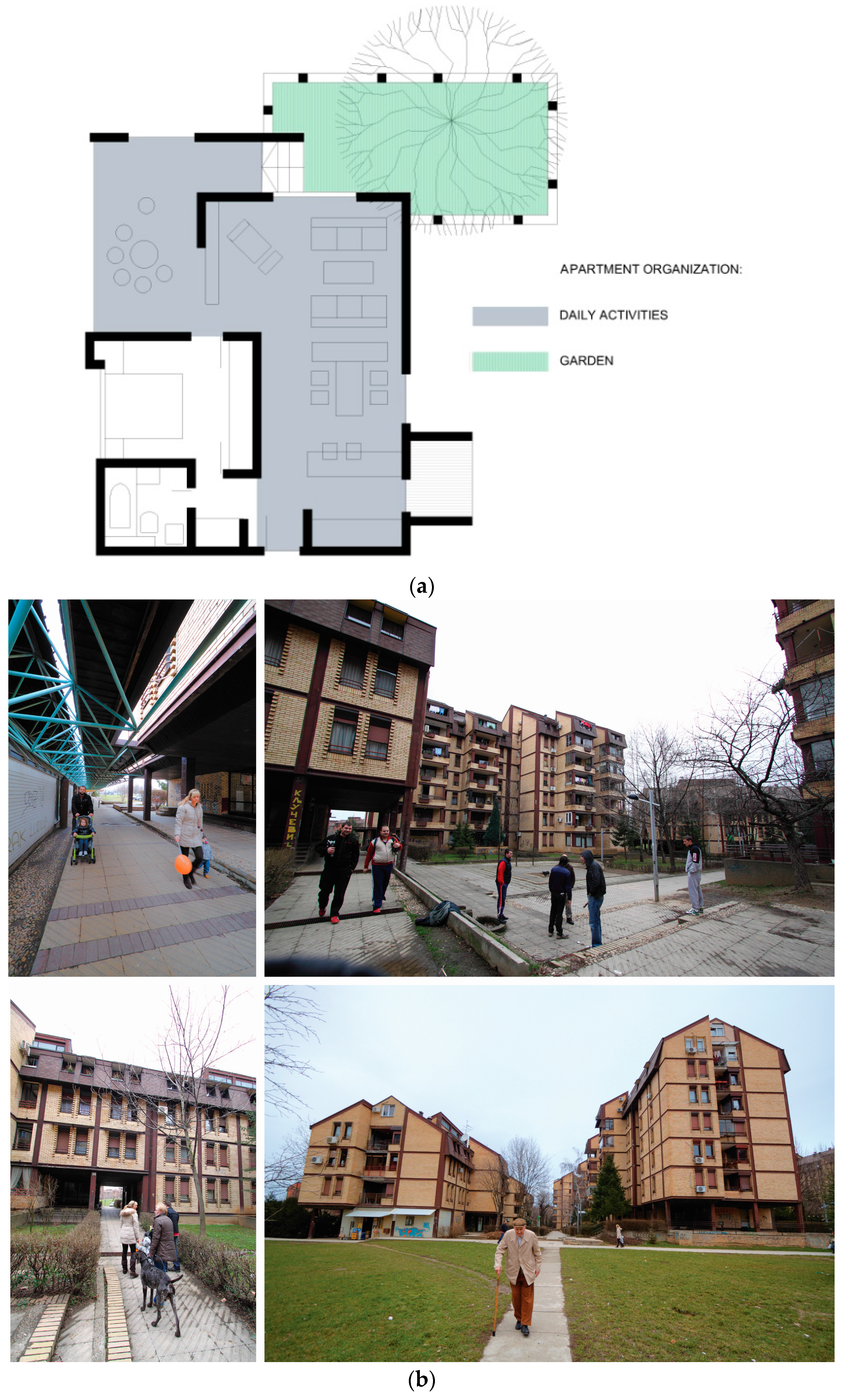
| Description | Architects | Origin of Design | Realization | |
|---|---|---|---|---|
| (1) | Blocks 1 and 2 in New Belgrade | Leonid Lenarčič, Milutin Glavički, Milosav Mitić and Dušan Milenković | competition, Belgrade, 1958–1959 | 1959–1963 |
| (2) | Block 21 in New Belgrade | Mihailo Čanak, Leonid Lenarčić, Milosav Mitić and Ivan Petrović | competition, Belgrade, 1958–1959 | 1962–1966 |
| (3) | Residential settlement “Julino brdo” | Milan Lojanica, Borivoje Jovanović and Predrag Cagić | competition, Belgrade, 1966 | 1967–1970 |
| (4) | Block 19a in New Belgrade | Milan Lojanica, Predrag Cagić, Borivoje Jovanović, Radisav Marić and Radmila Lojanica | competition, Belgrade, 1975 | 1977–1982 |
| (5) | Residential settlement “Cerak vinogradi” (Cerak 1 and Cerak 2) | Darko Marušić, Milenija Marušić and Nedeljko Borovnica | competition, Belgrade, 1977 | 1979–1989 |
© 2016 by the authors; licensee MDPI, Basel, Switzerland. This article is an open access article distributed under the terms and conditions of the Creative Commons Attribution (CC-BY) license (http://creativecommons.org/licenses/by/4.0/).
Share and Cite
Djokić, V.; Ristić Trajković, J.; Krstić, V. An Environmental Critique: Impact of Socialist Ideology on the Ecological and Cultural Sensitivity of Belgrade’s Large-Scale Residential Settlements. Sustainability 2016, 8, 914. https://doi.org/10.3390/su8090914
Djokić V, Ristić Trajković J, Krstić V. An Environmental Critique: Impact of Socialist Ideology on the Ecological and Cultural Sensitivity of Belgrade’s Large-Scale Residential Settlements. Sustainability. 2016; 8(9):914. https://doi.org/10.3390/su8090914
Chicago/Turabian StyleDjokić, Vladan, Jelena Ristić Trajković, and Verica Krstić. 2016. "An Environmental Critique: Impact of Socialist Ideology on the Ecological and Cultural Sensitivity of Belgrade’s Large-Scale Residential Settlements" Sustainability 8, no. 9: 914. https://doi.org/10.3390/su8090914






